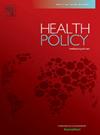取消自付药费对低收入家庭的影响:使用不列颠哥伦比亚省相关行政数据的受控中断时间序列分析
IF 3.6
3区 医学
Q1 HEALTH CARE SCIENCES & SERVICES
引用次数: 0
摘要
人们对减少处方药的自付费用很感兴趣,但这种干预措施的效果尚不清楚。目的研究加拿大不列颠哥伦比亚省(BC)取消低收入家庭共同支付的公共处方药保险计划变化的影响。方法:我们使用BC省人口数据中心2017年至2021年的行政数据和受控中断时间序列设计来检查2019年的一项政策,该政策取消了收入低于13750美元的家庭的共同支付。收入超过4.5万美元的家庭作为对照组,他们没有经历公共保险的变化。我们的主要结果是处方药支出和处方分发数量。我们还进行了前后分析,以研究对治疗班级的分配和支出的影响。结果干预队列包括9095名患者,代表8011户家庭,平均年龄为48.4岁。对照队列包括820,395名患者,代表471,778个家庭,平均年龄为51.1岁。取消共同支付导致每月药品支出增加3.85美元(95% CI: 1.13 - 7.03美元),对趋势没有影响。平均配药数量增加了0.07张(95% CI: 0.04 ~ 0.09),配药率每月增加了0.006张(95% CI: 0.002 ~ 0.010)。在大多数治疗类别中,共同支付的取消与支出和分配的增加有关。解释:BC省低收入家庭的共同支付取消导致处方药支出和跨药物类别分配的显着增加。取消共同支付似乎有效地改善了低收入家庭获得药品的机会。本文章由计算机程序翻译,如有差异,请以英文原文为准。
The impact of eliminating out-of-pocket payments for medicines on low-income households: a controlled interrupted time series analysis using linked administrative data from British Columbia
Background
There is interest in reducing out-of-pocket payments for prescription medicines, but the effects of such interventions remain unclear.
Objective
To study the impact of changes to the public prescription drug insurance program in British Columbia (BC), Canada that eliminated copayments for low-income households.
Methods
We used administrative data from 2017 to 2021 from Population Data BC and a controlled interrupted time-series design to examine a 2019 policy that eliminated copayments for households with incomes below $13,750. Households with incomes over $45,000—who experienced no changes in public coverage—served as a control. Our primary outcomes were prescription drug expenditures and the number of prescriptions dispensed. We also conducted a pre-post analysis to study impacts on dispensing and expenditures across therapeutic classes.
Results
The intervention cohort included 9,095 patients representing 8,011 households with an average age of 48.4. The control cohort included 820,395 patients representing 471,778 households with an average age of 51.1. Copayment elimination led to a level increase of $3.85 (95 % CI: $1.13 - $7.03) in monthly drug expenditures and had no impact on the trend. The mean number of prescriptions dispensed had a level increase of 0.07 (95 % CI: 0.04 – 0.09) and the rate of dispensing increased by 0.006 prescriptions monthly (95 % CI: 0.002 – 0.010). Copayment elimination was associated with increased expenditures and dispensing across most therapeutic classes.
Interpretation
Copayment elimination for low-income households in BC led to significant increases in prescription drug expenditures and dispensing across drug classes. Eliminating copayments appears to be effective at improving access to medicines for lower-income families.
求助全文
通过发布文献求助,成功后即可免费获取论文全文。
去求助
来源期刊

Health Policy
医学-卫生保健
CiteScore
6.40
自引率
6.10%
发文量
157
审稿时长
3-8 weeks
期刊介绍:
Health Policy is intended to be a vehicle for the exploration and discussion of health policy and health system issues and is aimed in particular at enhancing communication between health policy and system researchers, legislators, decision-makers and professionals concerned with developing, implementing, and analysing health policy, health systems and health care reforms, primarily in high-income countries outside the U.S.A.
 求助内容:
求助内容: 应助结果提醒方式:
应助结果提醒方式:


